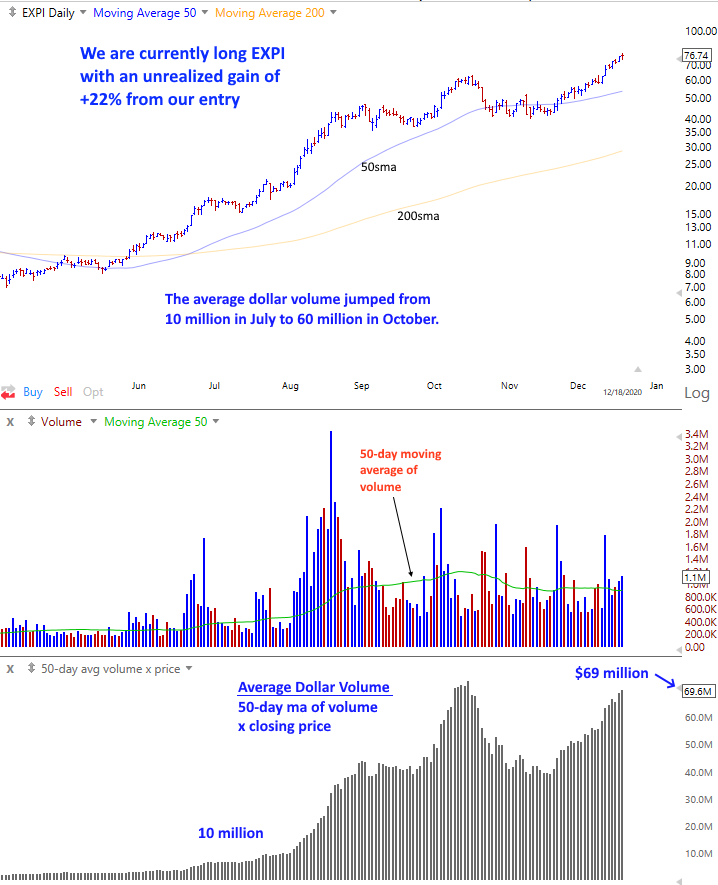Having sufficient trading volume in the stocks and ETFs you trade helps ensure liquidity in your transactions. In this post, we share our top tips to help you easily determine “How much volume is enough?”
Trading volume is the total number of shares of a security that are traded in a market during a given period of time.
The more shares that are traded each day, the higher the liquidity of that stock or ETF.
Stocks and ETFs with higher liquidity generally have a tighter spread (margin between the bid/ask price), which can aid in the profitability of your trades.
High liquidity also helps ensure there is enough demand to easily facilitate a large stock trade without significantly affecting its price.
But how much daily volume is really enough to ensure sufficient liquidity for swing trading stocks and ETFs?
Continue reading to discover the simple rules we use for ensuring the pre-screened stock picks in our swing trading report always have plenty of liquidity.
What is Average Daily Trading Volume? Why does it matter?
Average Daily Trading Volume (“ADTV”) is a measure of the number of shares traded per day, averaged over a specific period of time (we recommend 50 days).
Knowing the ADTV of a stock enables you to quickly assess its liquidity.
A stock with a high ADTV is highly liquid, which means you can easily enter and exit swing trades without directly influencing the stock’s price.
Conversely, a stock with an extremely low ADTV should be avoided because it is not liquid enough to ensure smooth trade executions.
Knowing the ADTV also helps identify important “volume spikes”–the footprint of institutional accumulation and a major technical indicator when choosing the best growth stock setups for our model portfolio.
If, for example, a stock with an ADTV of 600,000 shares suddenly trades 3,000,000 shares one day, it means trading volume spiked to 5 times (500%) its average daily volume level.
If such a volume spike was also accompanied by a large daily price gain, it indicates that banks, mutual funds, hedge funds, and other institutions were accumulating the stock.
Since roughly 80% of the stock market’s average daily volume is the result of institutional trading, owning stocks under accumulation tilts the odds of success in your favor.
Pay close attention to changes in a stock’s daily volume levels because it is one of the most powerful and reliable technical indicators to predict future price action.
 4 key questions to determine if a stock has enough liquidity (average daily trading volume)
4 key questions to determine if a stock has enough liquidity (average daily trading volume)
Average daily trading volume alone can be used as a “line in the sand” to determine if a stock is liquid enough to trade, but there are many other factors that play a part in the role.
Check out the four key questions below to help you determine whether a stock can be traded or is better left alone.
1. How many shares do I plan to trade? Size matters!
If you are only planning to buy 100 shares of a stock, the ADTV is pretty much a non-issue because it will be easy to exit such a small position–even in a thinly traded stock.
However, if you have a larger trading account and intend to buy thousands of shares, you need to more seriously consider whether or not it will be difficult to eventually close your position with minimal slippage and volatility.
Regardless of what you may have heard, size does matter (at least when it comes to stocks).
2. What is the stock’s Average Dollar Volume?
Not to be confused with Average Daily Trading Volume, Average Dollar Volume is a ratio that is calculated by multiplying the share price of a stock times its ADTV.
For example, a $25 stock with an ADTV of 800,000 shares has an Average Dollar Volume of 20 million ($25 x 800,000).
If a $100 stock has an ADTV of just 200,000 shares, it would be the same Average Dollar Volume of 20 million ($100 x 200,000).
For institutional investors and traders who rely on sufficient liquidity for large positions, Average Dollar Volume is a more important number than ADTV.
In the examples above, an institutional trader would consider both the $25 and $100 stocks to have equal liquidity.
With all swing trades in the Wagner Daily model portfolio, we typically pre-scan for a minimum Average Dollar Volume of 20 million.
If you trade a rather large account, then consider an Average Dollar Volume above 80 million to ensure plenty of liquidity.
Knowing the Average Dollar Volume of a stock means you can sometimes lower your minimum ADTV requirement if the stock is also trading at a higher price.
3. How long do I plan to hold the trade?

Are you a daytrader, swing trader, or position trader?
The duration of time you typically hold your positions also helps determine the minimum average daily trading volume to require for your trades (press here for a comparison of trading timeframes).
A daytrader who focuses on making quick, but smaller gains should focus on trading “thick” stocks where millions of shares change hands every day–stocks with tight bid/ask spreads and extremely high liquidity.
Tesla ($TSLA), for example, is a fantastic stock for daytrading because it possesses both high liquidity and intraday volatility.
On the other hand, a position trader who rides the profit in an uptrending stock for many months can trade a less liquid stock because positions can be scaled out over the course of several days or weeks.
To learn more about scaling out of winning trades, check out our educational blog post on exactly how we scaled out of our $TSLA trade for a +118% gain.
As a general rule, higher average daily trading volume becomes more important as the trading timeframe decreases.
4.) Am I trading individual stocks or ETFs?
In individual stocks, ADTV and Average Dollar Volume directly determine a stock’s liquidity.
However, it’s a different scenario with ETFs (exchange traded funds).
Average daily volume levels of ETFs are largely irrelevant because ETFs are open-end funds.
This means new units (shares) can be created or redeemed as necessary–actual supply and demand has little effect on the price (unlike with stocks).
Even if an ETF has no buyers or sellers for several hours, the bid and ask prices continue to move in correlation with the market value of the ETF, which is derived from the prices of individual underlying stocks.
As such, you should be much less concerned with the ADTV of an ETF than with an individual stock.
NOTE: Although liquidity is not a concern when trading ETFs, you should still be aware that ETFs with an extremely low ADTV may have wider spreads between the bid and ask prices.
To learn more, check out Why ETF Trading Volume Does Note Determine ETF Liquidity.
How to quickly and easily determine the liquidity of a stock or ETF
The fastest and easiest way to gauge the liquidity of a stock is by plotting Average Daily Trading Volume (ADTV) and Average Dollar Volume (ADV) indicators on your stock charts.
These technical indicators may not be available on some of the free charting platforms, but is not a problem with more robust stock trading and analysis platforms such as TradeStation or TC2000.
The TC2000 chart below shows a simple way to display ADTV and ADV:

The top section of this chart shows the price action (and a few moving averages), the middle shows daily volume bars and 50-day ADTV, and the bottom bars plot the Average Dollar Volume (in millions).
With an ADTV of nearly 1.1 million shares and an Average Dollar Volume of 69 million, this stock would be considered a highly liquid, “institutional friendly” stock.
Don’t get too hung up about the minimum volume for swing trading stocks
If you want to avoid surprise price reactions when it is time to close your positions, pay attention to the ADTV and/or Average Dollar Volume of the stocks you’re trading–especially if you are trading a sizable account.
Doing so ensures there is sufficient liquidity to prevent your own buying and selling from directly affecting the stock’s price.
Nevertheless, determining if a stock has sufficient liquidity is not as clear-cut as merely picking an arbitrary number–such as 500,000 minimum shares per day.
Remember that Average Dollar Volume gives a more complete and accurate picture of a stock’s true liquidity, compared to just knowing the ADTV.
Your individual trading timeframe also plays a role in determining which stocks trade enough volume each day.
Frankly, we feel many individual traders get too hung up about the average daily trading volume of a stock.
Unless you’re operating a massive individual trading account, your individual transactions within a stock will typically have a minimal (if any) effect on the price.
Further, you don’t need to worry about liquidity if you simply focus on trading leading growth stocks with strong institutional support.
If a company has a history of outstanding earnings growth, or perhaps a revolutionary product that sells like suntan lotion at the beach, it can even be okay to buy a thinly traded stock.
In this case, just be sure to reduce your share size to compensate for greater price volatility.
What are your personal minimum volume requirements for stock trading? Which factors are most important to you? Drop us a comment below.


It’s usually so difficult to get your head round trading, do you trade yourself ?
Yes, I ran a hedge fund and am currently still professionally trading. I also occasionally handle managed accounts for our clients.
I hope you enjoyed this important article about volume. Please be sure to check out the thousands of other blog posts to help you in your quest for trading success!
Well written article, out of curiosity, some biotech equities that are still in the r&d phase tend to trade between the .20 and .50 range with about 250 k daily volume.. Be interesting to know if 40,000 dollars worth of shares were to be bought what that would do to the share price? if anything?
Are there separate liquidity issues for leveraged ETFs?
Leveraged ETFs work in a similar manner, except that they use derivatives to achieve the leverage.
Sir ,
I wanted to know average and current volume of stocks for screening of stocks – small ,mid and large caps
Virgilwilliams
I trade only in the KLSE stocks.